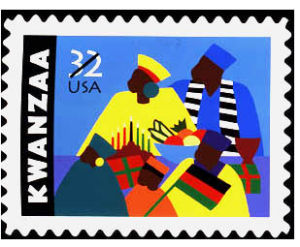Kwanzaa celebrates African values and heritage
December 2, 2009
Kwanzaa is a holiday, celebrated by African Americans from Dec. 26 through Jan. 1. It is based on the agricultural “first fruits” celebrations of Africa. The holiday gets its name from the Swahili phrase matunda ya kwanza, which directly translates into fruits first in English.
The first fruits celebrations are recorded in African history as far back as ancient Egypt, and continue to be celebrated today by many throughout the African continent.
Kwanzaa was created to “introduce and reinforce seven basic values of African culture which contribute to building and reinforcing family, community and culture among African American people as well as Africans throughout the world African community. These values are called the Nguzo Saba which in Swahili means the Seven Principles,” said
Kwanzaa founder Dr. Maulana Karenga on the official Kwanzaa Web site.
Umoja, or Unity in English, is the first of Nguzo Saba. Followed with Kujichagulia, (self-determination) Ujima, (collective work and responsibility) Ujamaa, (cooperative economics), Nia, (purpose) Kuumba, (creativity) and Imani (faith).
Just as there are seven days, and seven principles, there are also seven symbols of Kwanzaa. These symbols are both traditional and non-traditional items that represent concepts which, “evolved out of the life and struggle of the African American people,” said Karenga in his book, Kwanzaa: A Celebration of Family, Community and Culture.
These seven symbols are: mazao (the crops), mkeka (the mat), kinara (the candle holder), muhindi (the corn), mishumaa saba (the seven candles), kikombe cha umoja (the unity cup), and zawandi (the gifts). Those who celebrate Kwanzaa use each of these symbols as part of the festivities.
On the first day of Kwanzaa each year, the typical practice is to select a centrally located table and drape a piece of African cloth over it. Next, the mkeka is placed down on top of the cloth and all of the other symbols are placed on it or immediately next to it. The kinara is placed on the mat and the Mishumaa Saba, which represent both the seven principles and days of Kwanzaa are placed in the kinara. A candle is lit every day of the holiday to symbolize each of the Nguzo Saba.
Each day of Kwanzaa the family or group celebrating sit down, usually at meal times, and talk about the principle for that particular day. The family also participates in various cultural building activities based on these concepts.
One of the most important aspects during Kwanzaa is pouring the tambiko, or libation in honor of their African ancestors. Tambiko is performed by pouring a cup of water or juice over a large bowl of green leafy vegetables and reciting a tamshi la tambiko (libation statement), which was written by Karenga in honor of significant tasks begun by African ancestors.
Umoja night is another central celebration of Kwanzaa. The celebration involves music, poetry, and community candle lighting. The Karamu, or feast is celebrated on Dec. 31 and “is a very special occasion because it is a community and cooperative project of ceremonies, tambiko, cultural expressions, and a magnificent feast of various foods prepared by all attending,” said Karenga in his book, Kwanzaa: a celebration of family, community and culture.
Locally, it seems those who celebrate Kwanzaa within the African American community are the minority. “I never really thought about celebrating Kwanzaa,” said Topeka resident Chevas White. “It’s probably because I don’t really know much about it and wouldn’t know how to go about celebrating it.”
Esoke, a local African dance and drum ensemble will perform traditional African dance and music as an expression to celebrate Kwanzaa, will perform at the Kansas City Library Monday, Dec. 21 at 7:00 p.m.



